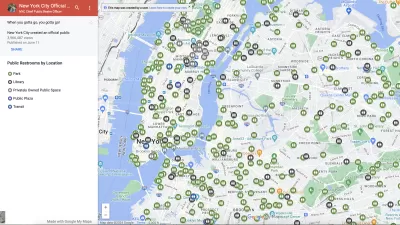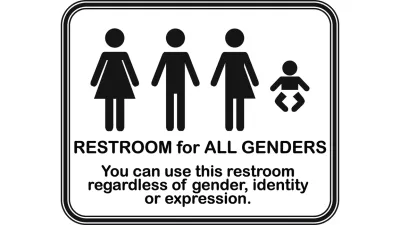There are several reasons that gender neutral bathrooms will soon replace separated men's and women's bathrooms, and they have nothing to do with gender identity, explains Jimmy Parker, event producer and former BID director.

Gender neutral bathrooms are just better. It has nothing to do with gender identity or current affairs. There are several reasons that gender neutral bathrooms will soon replace separate men's and women's bathrooms, explains event producer and the long time president of San Diego's Gaslamp Quarter Association—a Businsess Improvement District. A few of the reasons include:
Benefits
Once you begin to design standardized approaches to public restroom facilities, certain benefits will be realized. Here are a few:
- No need to calculate use based on demographics.
- No duplication of hand wash stations, signage, lighting, and general access corridors
- Easier family use (Fathers with daughters, Mother with sons)
- Easier calculation/conformance with ADA standards
Safety
This area seems to be where the greatest passion exists on both sides of the political debate, but I would ask the reader to consider the following:
- Unisex restrooms (shared areas) are easier to patrol with security personnel. With separate facilities, sex-specific guards need to be available to respond to emergencies/concerns.
- Greater traffic increases safety. The potential of swifter response to inappropriate behavior is a great deterrent.
- Children can be accompanied by both parents/grandparents. Especially important with multiple children.
- Stalls, unlike urinal dividers, can be re-enforced to provide better (not complete) protection when people need to shelter in place during violent incidents.
Parker concludes by asking planners and municipalities to remove remove regulatory obstacles to their implementation and to develop standards to allow all large scales public projects to have gender neutral bathroom facilities.
FULL STORY: A Planner’s Opportunity – Gender Neutral Facilities

Montreal Mall to Become 6,000 Housing Units
Place Versailles will be transformed into a mixed-use complex over the next 25 years.

Planetizen Federal Action Tracker
A weekly monitor of how Trump’s orders and actions are impacting planners and planning in America.

Four Reasons Urban Planners Can’t Ignore AI
It’s no longer a question of whether AI will shape planning, but how. That how is up to us.

High Housing Costs Driving Down Transit Ridership in LA
When neighborhoods gentrify and displace lower-income residents, transit ridership suffers, new research shows.

Iowa Legalizes Accessory Dwelling Units
A new law will allow property owners to build ADUs on single-family lots starting on July 1.

NYC Council Approves Brooklyn Rezoning Plan
The Atlantic Avenue Mixed Use Plan includes infrastructure investments and could bring 4,600 new housing units to parts of Brooklyn.
Urban Design for Planners 1: Software Tools
This six-course series explores essential urban design concepts using open source software and equips planners with the tools they need to participate fully in the urban design process.
Planning for Universal Design
Learn the tools for implementing Universal Design in planning regulations.
City of Camden Redevelopment Agency
City of Astoria
Transportation Research & Education Center (TREC) at Portland State University
City of Camden Redevelopment Agency
Municipality of Princeton (NJ)
Regional Transportation Commission of Southern Nevada




























